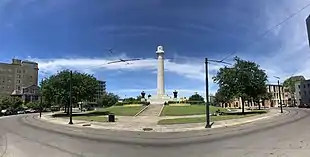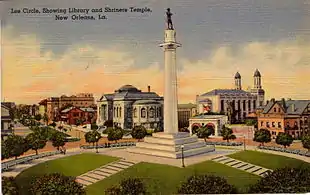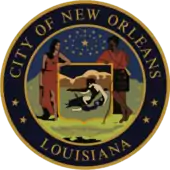Lee Circle
Lee Circle is a central traffic circle in New Orleans, Louisiana, which featured a monument to Confederate General Robert E. Lee between 1884 and 2017. The monument was a bronze statue by Alexander Doyle, a prominent American sculptor known for statues of Civil War figures. Lee Circle is located at the intersection of St. Charles and Howard Avenues. Prior to the erection of the monument, the location was known as Tivoli Circle or Place du Tivoli.[1][2][3] Tivoli Circle was an important, central point in the city, as it linked upriver areas with downriver areas. It was a common local meeting point and the site remains a popular place to gather for Mardi Gras parades.


Renaming controversies
On July 31, 1877, "Lee Place" within "Tivoli Circle" was authorized by Ordinance A.S. 4064[4][5] Although the traffic circle is commonly referred to as "Lee Circle", this ordinance makes clear that the "enclosure" containing the statue is to be known as "Lee Place", while the traffic circle itself continues to be known as "Tivoli Circle". This ordinance contains no reference to the name "Lee Circle".
On June 24, 2015, New Orleans Mayor Mitch Landrieu acknowledged the impact of the June 2015 Charleston church shooting but credited a 2014 conversation with New Orleans jazz ambassador Wynton Marsalis for his decision to call for the removal of the Lee statue and renaming of Lee Circle and other city memorials of Confederate slaveholders.[6]
As part of a sixty-day period for public input, two city commissions called for the removal of four monuments associated with the Confederacy: the Lee statue, statues of Jefferson Davis and P.G.T. Beauregard, and an obelisk commemorating the "Battle of Liberty Place". Governor Bobby Jindal opposed the removals.[7]
On December 17, 2015, the New Orleans City Council voted to remove the four monuments from public display.[8][9] Four organizations immediately filed a lawsuit in federal court the day of the decision and the City administration agreed that no removals would take place before a court hearing.[10]
Removal of the Lee statue
On May 18, 2017, the City of New Orleans announced that the Lee statue would be removed at 9 a.m. the following day. This was the last of the four Confederate memorials to be removed by the city.[11] The city also announced that the statue would be replaced with a water feature.

The removal of the Lee statue was completed on the evening of May 19 at 6 p.m. C.D.T., a departure from the other removals which occurred during early morning hours under the cover of darkness.
On February 23, 2019, a rider was banned for life from a Mardi Gras parade for throwing beads bearing the likeness of the Lee statue, which she had created and sold online as a business venture for profit. The beads were against a city ordinance that restricts advertising and political messaging, and were known to be non-compliant within Orleans Parish.[12]
| Wikimedia Commons has media related to Lee Circle, New Orleans. |
References
- Douglas, Lake (2011). Public Spaces, Private Gardens: A History of Designed Landscapes in New Orleans. Baton Rouge: Louisiana State University Press. pp. 250–251, n. 25. ISBN 978-0-8071-3837-3.
Using "Tivoli" as a place-name first appeared in New Orleans in 1807, when the engineer Barthélémy Lafon drew subdivision plans for the Delord-Sarpy Plantation property above Canal Street in the Faubourgs Ste. Mary and Annunciation. He created the Place du Tivoli, encircled first by the Tivoli Canal and then by a paved street; this traffic circle was renamed in honor of Gen. Robert E. Lee in the 1870s. Another use of Tivoli occurs with a plantation and garden on nearby Bayou St. John from 1808 through 1824, discussed above. Some may conflate these into one location, an understandable conclusion since early notices of Tivoli Plantation mention garden features and the Carondelet Canal is an extension of Bayou St. John.
- Kane, Harnett (1961). Place du Tivoli: A History of Lee Circle. Boston: John Hancock Mutual Life Insurance Company. Published on the occasion of the dedication of the John Hancock Building (now known as K&B Plaza), New Orleans, LA, December 7, 1961.
- "Tivoli Circle - Lee Circle". Old New Orleans. Retrieved 2011-12-04.
- Jewell, Edwin L. (1882). "Title XIV, Ch. 2, §I, Art. 19(3)". Jewell's Digest of the City Ordinances Together with the Constitutional Provisions, Acts of the General Assembly and Decisions of the Courts Relative to the Government of the City of New Orleans. New Orleans: Edwin L. Jewell. p. 291.
That the ground within the enclosure to be so improved, shall be dedicated to the memory of General Robert E Lee, and as soon as the work is commenced, shall thereafter be known as Lee Place, but the name of the outer or street portion shall still be preserved under the designation of Tivoli Circle.
- Hobgson, W. I. (August 31, 1884). "Lee Place - Tivoli Circle". New Orleans, LA: The Times-Picayune. Retrieved 9 July 2015.
I quote from the ordinance giving its name. Ordinance 4064, A.S. - Adopted July 31, 1877, reads as follows: "SEC 3. Be if further ordained, etc., That the ground within the inclosure to be so improved, shall be dedicated to the memory of General Robert E. Lee, and as soon as the work is commenced shall thereafter be known as 'Lee Place,' but the name of the outer or street portion shall still be preserved under the designation of 'Tivoli Circle.' " W. I. Hobgson Secretary Lee Mon'l Ass'n.
- McClendon, Robert (June 24, 2015). "Mitch Landrieu on Confederate landmarks: 'That's what museums are for'". The Times-Picayune. Retrieved 9 July 2015.
Landrieu recalled Marsalis saying. When the mayor asked why, Marsalis responded, "Let me help you see it through my eyes. Who is he? What does he represent? And in that most prominent space in the city of New Orleans, does that space reflect who we were, who we want to be or who we are?"
- Schachar, Natalie (August 15, 2015). "Jindal seeks to block removal of Confederate monuments in New Orleans". Los Angeles Times. Retrieved 17 August 2015.
- Rainey, Richard (December 17, 2015). "Lee Circle no more: New Orleans to remove 4 Confederate statues". The Times-Picayune. Retrieved 17 December 2015.
- Adelson, Jeff (December 17, 2015). "New Orleans City Council votes 6-1 to remove Confederate monuments". The New Orleans Advocate. Retrieved 17 December 2015.
- Sayre, Katherine (December 18, 2015). "New Orleans won't remove Confederate statues before court hearing". The Times-Picayune. Retrieved 19 December 2015.
- http://www.nola.com/politics/index.ssf/2017/05/confederate_monuments_water_fe.html
- "Rider banned from Krewe of Freret for throwing 'Forever Lee Circle' beads". WGNO. 2019-02-27. Retrieved 2019-06-06.
Further reading
- Brock, R. A., ed. (1886). "Ceremonies Connected with the Unveiling of the Statue of General Robert E. Lee at Lee Circle, New Orleans, February 22, 1884". Southern Historical Society Papers. 14. Southern Historical Society. pp. 62–96.
- Brock, R. A., ed. (1886). "Historical Sketch of the R.E. Lee Monumental Association of New Orleans". Southern Historical Society Papers. 14. Southern Historical Society. pp. 96–99.
- Kane, Harnett (1961). Place du Tivoli: A History of Lee Circle. Boston: John Hancock Mutual Life Insurance Company. Published on the occasion of the dedication of the John Hancock Building (now known as K&B Plaza), New Orleans, LA, December 7, 1961.
- Kingsley, Karen (2003). Buildings of Louisiana. Buildings of the United States. Oxford: Oxford University Press. pp. 112–113. ISBN 978-0195159998.
- Larino, Jennifer (June 24, 2015). "The history of New Orleans' Lee Circle". New Orleans, LA: The Times-Picayune. Retrieved 9 July 2015.

